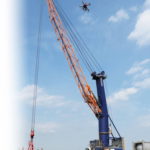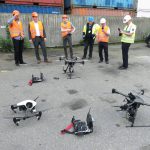The use of drones is a frequently discussed topic with a wide range of opinions. Some see a possibility to actually increase security while to others these unmanned flying robots represent a potential risk.
In the maritime branch the interest in drones is rising. First companies are already using this technology for inspecting offshore[ds_preview] wind farms or other equipment. This can reduce overall inspection costs due to significantly reduced inspection times and immediate video analysis while at the same time diminishing the risks for industrial climbing personnel.
In Hamburg, a discussion between representatives of authorities, the industry and harbour operators recently dealt with the opportunity of increasing maritime security in harbour facilities by using drones. For demonstration purposes several drone types started their flight at a terminal in the port of Hamburg and began to observe the terminal operations.
The event was planned by Condor Security, a German provider of security solutions, and hosted by Terminal Security Officer Peter Geest on his facility. »This topic is of special interest to me and I am glad to host their tests on my quay,« said Geest. He was surprised by the range of capabilities of the flying robots. Among the participants of the event there also was service provider »Unmanned Aerial Vehicle (UAV) International«, a Dutch company founded by Roel Van der Wal which already provides drone services for enterprises like Shell, Vestas or Tennet. Their customers already benefit from the low inspection costs, which is the reason why Van der Wal appreciates the highest potential and expects growing future demand within the offshore wind sector and other energy-related industries.
During the event, proponents highlighted the almost risk-free ability of transferring valuable information through »flying cameras« that can be operated on the spot when needed. »Drones add value to any facility where complex operations require a new perspective that adds informational value in cases of incidents – both with a safety and security threat,« states Michael Weickhardt, Sales- and Business Development Manager of Hamburg-based Condor International and Maritime Services (IMS). This includes the inspection of roofs, gears, cranes or areas difficult to access from the ground. The bird’s-eye view may furhtermore assist in visualising traffic flows or the best positioning of rescue personnel in case of an incident. In the event of fire, a drone can even do more than just watch the area, it can actively collect measurements e.g. of hazardous smoke particles. This aspect is being researched by the TU Wageningen. For the purpose of the studies drones are being equipped with special sensor technologies meant to facilitate gathering of information in fire incidents.
For Weickhardt, who is also a trained port facility security officer (PFSO), when talking about using drones in harbour facilities, a major focus is on integrating them in case of incidents causing the facility’s danger level to rise. The drones can be fitted with highly evolved and cost-efficient surveillance technology and thus provide valuable services, especially when the International Ship and Port Facility (ISPS)-Code requires additional guarding and security activities under level 2 or 3. Drones flying over specific areas automatically guided via GPS coordinates already is a standard and best practice.
Regarding the potential for the use in harbour facilities both time and perspective are identified as crucial factors in cases of incidents. All parties involved benefit from information quickly gathered from the bird’s-eye view. As an exmple the incidents in Tjanjin in August 2015 or the fire on a RoRo carrier in the port of Hamburg in May 2013 have fanned the discussion on the advantages to be gained by using drones in such scenarios. Following this line of reasoning, they can provide information to better coordinate emergency personnel or logistics – work that otherwise would put persons in danger.
Rise of drones causes problems
According to Weickhardt the number of drone systems on the global market has risen from 750to 1,740 during the last ten years while the share of civilly and/or commercially used systems went up from 13% to 52%. He considers that the free availability of these relatively cheap systems adds to their risks. »The former pilot has changed into a consumer,« he worried. Especially the lack of standardised trainings as well as registration requirements for the pilot and the system increase the danger potential. Weickhardt divides the overall risk in safety and security components. The first describes accidents caused by falling or otherwise uncontrollable drones leading to injuries or death. The second deals with active espionage or attacks where drones are used for transporting explosives.
When using drones it is important to identify any potential risk from the very beginning. At the Hamburg event, the professional user stated that a well-trained professional pilot is able to identify, calculate and thus considerably reduce any risk connected with his drone’s activity.
Current regulations in Germany allow the use of drones with a total payload of up to 25 kg under certain circumstances and after an official permission combined with a notification to the local police. Privately used drones under 5 kg payload require no permission at all. All participants in the Buss Hansa terminal event, however, were sure that those regulations do not hinder any person with criminal intentions.
In Hamburg, strict rules apply for the use of drones in the majority of the city area. According to official statements this is due to the short distances between port facilities, airport and the city center. On the other hand this shows »that an incident in the port could easily and quickly endanger civilians if not controlled properly exactly because of these short distances. Restrictions should generally be applied but must not hinder drone assistance in special situations,« Weickhardt believes. The argument of the proponents suggests an appropriate collaboration between professional drone pilots and officials. Thomas Reinecke, former police reporter and active drone expert in Hamburg, suggests stricter regulations for private consumers while providing controlled but simplified regulations for professionals.
The police representatives, however, favour a much more critical perception of any drone activities and would prefer a zero-tolerance strategy. »The absence of flight activities prevents any potential risks from the beginning,« is their argument and they point out that a suspicious drone can only be stopped by detecting its pilot. Any active intervention causing the drone to fall would only add to the risk. The proponents’ counterargument that any criminal use or intention to actively cause damage cannot be forestalled this way remained unresolved in this context.
More and advanced drones
The general trend is pro drones as producers predict increasing payloads, longer flight times and reduced costs. A new generation is expected to enter the market in mid 2016 further enhancing the technological potential of the robots. All speakers and guests of the Hamburg event are worried about possible accidents caused by drones that are involving people as they may even cause fatalities. »Given a proper use and consumer regulations the potential of saving lives in an incident will, however, outweigh the danger of accidents,« Weickhardt and Reinecke agreed.
Condor IMS suggests the implementation of an operation center for coordinating drone operations. It could take care of the proper distribution of gathered information to all officials in cases of maritime and other incidents. It could also manage and operate professional drone flights during cruise arrivals or other official events. From a port management perspective the number of civilians inside a facility is very limited and all personnel already wear safety equipment when working outside. So the operative risk caused by drones in ports is already low.
The Terminal Security Officer can imagine using drones in port facilities in a not so distant future.
Thomas Wägener





















